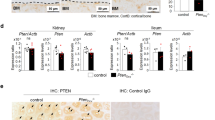Abstract
In previous works we have found a mitochondrial alkaline phosphatase (AP) activity in LLC-PK1. The aim of this work has been to study the possible involvement of mitochondrial AP activity in the synthesis of 1,25-dihydroxyvitamin D3 (1,25(OH)2D3) and 24,25-dihydroxyvitamin D3 (24,25(OH)2D3) from the substrate 25(OH)D3. Renal phenotype LLC-PK1 cells were incubated with 25(OH)D3 as substrate and treated with or without 1,25(OH)2D3, forskolin, 12-myristate-13-acetate (PMA) and 1,25(OH)2D3 in conjunction with PMA. Incubation of LLC-PK1 cells with forskolin (adenylate cyclase activator) not only stimulated the 1-hydroxylase and inhibited the 24-hydroxylase activities but also increased the mitochondrial AP activity. The addition of 1,25(OH)2D3, the main activator of 24-hydroxylase, produced a decrease of mitochondrial AP activity, a decrease of 1,25(OH)2D3 synthesis and an increase of the 24,25(OH)2D3 synthesis. Incubation with PMA, a potent activator of protein kinase C, did not produce any changes in mitochondrial AP activity, but an inhibition of 1,25(OH)2D3 and an activation of 24,25(OH)2D3 synthesis were found. Moreover, incubation of LLC-PK1 cells with PMA in conjunction with 1,25(OH)2D3 produced an additive effect in the decrease of 1,25(OH)2D3 and an increase of 24,25(OH)2D3 synthesis remaining mitochondrial AP activity as cells treated only with 1,25(OH)2D3. Our results suggest that mitochondrial AP activity could be involved as an intracellular signal in the regulation of 25(OH)D3 metabolism to the synthesis of 1,25(OH)2D3 and 24,25(OH)2D3 in renal phenotype LLC-PK1 cells through cAMP protein kinase system.
Resumen
En trabajos previos hemos encontrado actividad FA mitocondrial en células LLC-PK1 de fenotipo renal. Se estudian en este trabajo la posible implicación de la FA mitocondrial en la síntesis de la 1,25-dihydroxyvitamin D3 (1,25 (OH)2D3) y de la 24,25-dihydroxyvitamina D3 (24,25(OH)2D3) en células de fenotipo renal LLC-PK1. Las células se incubaron con el sustrato 25-hydroxyvitamin D3 (25(OH)D3) en ausencia (control) y presencia de 1,25 (OH)2D3, forskolina, 12-myristate-13-acetato (PMA) o 1,25(OH)2 D3 junto con el PMA. La presencia de forskolina, activador de la adenilato ciclasa, no sólo estimuló la actividad de la 1-hidroxilasa e inhibió la actividad de la 24-hidroxilasa, sino que también incrementó la actividad de la FA mitocondrial. La incubación en presencia de 1,25(OH)2D3, principal activador de la 24-hidroxilasa, produjo descenso de la FA mitocondrial seguido de descenso de la síntesis de 1,25(OH)2D3 e incremento de la de 24,25(OH)2D3. Por otra parte, la presencia del PMA, potente activador de la proteína quinasa C, no produjo cambios en la actividad de la FA mitocondrial, pero se observó inhibición de la síntesis de 1,25(OH)2D3 y activación de 24,25 (OH)2D3. Por último, la incubación de las células LLC-PK1 conjuntamente con 1,25(OH)2D3 y PMA produjo efectos aditivos en el descenso de la síntesis de 1,25(OH)2D3 y en el incremento de la séntesis de 24,25 (OH)2D3, permaneciendo la actividad FA mitocondrial en niveles similares a los encontrados tras el tratamiento con 1,25(OH)2D3. Nuestros resultados sugieren que la actividad FA mitocondrial podría estar implicada como una señal intracelular en la regulación del metabolismo de la 25(OH)2D3 para sinterizar 1,25(OH)2D3 y 24,25(OH)2D3 en células de fenotipo renal LLC-PK1 a través del sistema cAMP-proteína quinasa A.
Similar content being viewed by others
References
Armbrecht, H. J., Wongsurawat, N., Zenser, T. V. and Davis, B. (1984):Am. J. Physiol.,246, E102–107.
Bell, R. M. (1986):Cell,5, 631–632.
Bland, R., Zehnder, S. V., Ronco, P. M. and Hewison, H. (2001):Kidney Int.,60, 1277–1286.
Borgers, M. (1973):J. Histochem. Cytochem.,21, 812–818.
Bradford, M. (1976):Anal. Biochem.,72, 248–254.
Fraser, D. R. and Kodicek, E. (1970):Nature,228, 764–766.
Ghazarian, J. G. (1990):Bone Min. Res.,5, 897–903.
Gray, R. W., Omdhal, J. L., Ghazarian, J. G. and De Luca, H. F. (1972):Biol. Chem.,247, 7528–7532.
Henry, H. L. (1992):J. Cell. Biol. Chem., 49, 4–9.
Henry, H. L. and Lutano, E. M. (1989):Endocrinology,124, 2228–2234.
Hruska, K. A., Goligorsky, M., Scoble, J., Tsutsumi, M., Westbrook, S. and Moskowitz, D. (1986):Am. J. Physiol.,251, 188–198.
Igebritsen, T. S. and Cohen, P. (1983):Science,221, 331–338.
Kano, J., Sugimoto, P., Fukase, M. and Chiara, K. (1994):Biochem. Biophys. Res. Commun.,199, 271–276.
Lowry, O. H., Roberts, N. R., Mei-Ling, W. V., Hixon, W. S. and Crawford, E. J. (1954):J. Biol. Chem.,207, 19–37.
Makita, T. and Sandborn, E. B. (1970):Histochemie,24, 99–105.
Mandla, S., Boneh, A. and Tenenhouse, H. S. (1990):Endocrinology,127, 2639–2647.
Mandel, M. L., Moorthy, B. and Ghazarian, J. G. (1990):Biochem. J.,266, 385–392.
Nemani, R., Ghazarian, J. G., Moorthy, B., Wongsurawat, N., Strong, R. and Armbrecht, H. L. (1989):J. Biol. Chem.,264, 14361–15366.
Nose, K. and Katsuta, H. (1974):Exp. Cell. Res.,87, 8–14.
Risco, F. and Traba, M. L. (1994):Magnes. Res.,7, 169–178.
Risco, F., Babé, M. and Traba, M. L. (1987):Clin. Chem.,33, 720–721.
Risco, F. and Traba, M. L. (1992):Magnes. Res.,5, 5–14.
Simboli-Campbell, M., Franks, D. J. and Welsh, J. (1992):Cell Signal,4, 99–109.
Simboli-Campbell, M., Gagnon, A., Franks, D. J. and Welsh, J. (1994):J. Biol. Chem.,269, 3257–3264.
Spencer, T. and Macrae, D. L. (1972):Enzymol.,42, 329–334.
Warner, M. (1982):J. Biol. Chem.,257, 12995–13130.
Author information
Authors and Affiliations
Rights and permissions
About this article
Cite this article
Municio, M.J., Traba, M.L. Mitochondrial alkaline phosphatase as an intracellular signal in the synthesis of 1,25(OH)2D3 and 24,25(OH)2D3 in LLC-PK1 cells. J. Physiol. Biochem. 59, 287–292 (2003). https://doi.org/10.1007/BF03179886
Received:
Issue Date:
DOI: https://doi.org/10.1007/BF03179886




